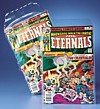Mylar, The Superior Comic Book
Protection Sleeve of Choice!

Mylar or more preferably, Type D is as good as it gets for protecting your comic books individually. If you are going to keep your magazines for any length of time, you will need to bag each one of them separately. While many collectors typically use polyethylene and polypropylene bags, Type D’s protection qualities will far outlast these materials. Other plastic material may protect your comic books for several months before they need replacing, but Type D will protect for years. More like hundreds of years. Your collection will definitely outlast you. And the picture above is courtesy of Bill Cole Enterprises, Inc located at www.bcemylar.com. More from Bill in a minute!
My-lar is a trade name of DuPont Teijin Films of Hopewell, VA, United States, for biaxially-oriented polyethylene terephthalate (BOPET) polyester film used for its high tensile strength, chemical and dimensional stability, transparency, and electrical insulation. A variety of companies manufacture BOPET and other polyester films under different trade names, but Mylar is often employed as a generic designation for these (boy that was a mouthful, wasn’t it).
Now all that being said, there is just one small problem. Dupont has quit manufacturing Type D. Oh no, you say, why are you telling me this then? Not to worry. Dupont is now manufacturing a replacement material call Melinex 516. Type D and Melinex 516 are the only materials accepted by the Library of Congress to protect their documents. There are many types of Mylar®, but only Type D was acceptable. Just as a side note, Melinex® and Mylar® are registered trademarks of DuPont Teijin Films.
Following is an excerpt from Bill Cole of Bill Cole Enterprises, Inc, which states protection requirements quite well. The full article is well worth reading and can be found with this discussion of Mylar protection. There is a more detailed discussion on how paper is made and why we need this kind of protection for our comic books.
GUIDELINES FOR PRESERVATION
First and foremost, keep your paper collectibles cool, dark and dry. Store books and other items in an unheated room, if possible, and regularly monitor the humidity. Excess heat and humidity should be controlled with an air conditioner and a dehumidifier. Storage materials such as envelopes, sleeves and boxes, should be of ARCHIVAL QUALITY only to prevent contamination of their contents.
According to the US Library of Congress, the preferred material for preserving valuable documents is uncoated archival quality polyester film, such as Type D or equivalent material such as Melinex® 516. My-lar® is an exceptionally strong transparent film that resists moisture, pollutants, oils and acids. With a life expectancy of hundreds of years, this sleeve material will outlast most other plastics. In addition, the brilliance and clarity of this material enhances the appearance of any paper collectible. (Mylar® is a registered trademark of DuPont Teijin films. Their brands of archival quality polyester films are Type D and Melinex® 516 of which they are exclusive manufacturers.)
POLYETHYLENE AND POLYPROPYLENE
For years collectors have stored their movie posters, comic books, baseball cards and other collectibles in polyethylene bags, PVC sheets and plastic wraps. Although such products may be useful in keeping away dirt, grease and vermin, many plastic sleeves contain plasticizers and other additives which can migrate into paper and cause premature aging. Both polyethylene and polypropylene contain solvents and additives in their manufacture to assure clarity and increase the flexibility in the plastic. Polyethylene when uncoated without any solvents is a good moisture barrier but has a high gas transmission rate, and eventually shrinks and loses its shape under warmer conditions.
In recent years polypropylene bags have been sold under the guise of being archivally sound. This is far from the truth. Only uncoated and untreated material is suitable for archival protection. Currently, the only way to seal polypropylene is to add a substance called PVDC (Polyvinyl Dichloride which is a relative of PVC) to allow the material to be heat sealed. Therefore, once you add the harmful additive, the sleeve now becomes non archival and should not be used for long term storage.
Final Thoughts
Now Melinex 516 is more expensive than your typical plastic bags. But
consider the cost of bag replacement every 5 or 6 months and the
possible loss of comic book value do to damage and aging. Then isn’t it
wiser and more cost effective to invest in Melinex bags for protection?
Think of all the time and energy you have been putting into your comic
book collection. And if you have an appetite for more Mylar, be sure to check out what Bill has for you over at Bill Cole Enterprises.
Has this page interested you? Would you like to hear more about
protective bags? As I come across other interesting information in the comic
book world, I will add it to my newsletter. If you want to keep up on
Mylar, Melinex and other supply resources, then feel free to sign up for
my newsletter “Comics Galore” in the form below.









New! Comments
Have your say about what you just read! Leave me a comment in the box below.